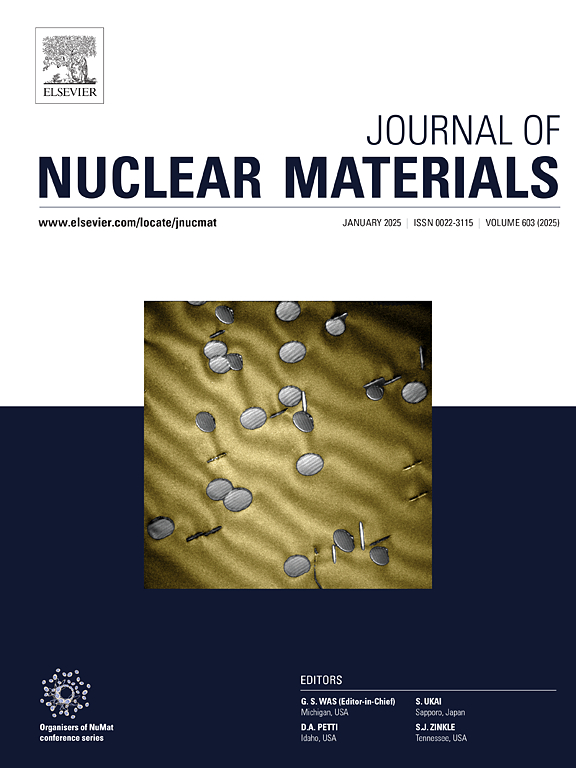增材制造316L不锈钢的强度和延展性:中子辐照和数据变异性的影响
IF 3.2
2区 工程技术
Q3 MATERIALS SCIENCE, MULTIDISCIPLINARY
引用次数: 0
摘要
本文介绍了用激光粉末床熔合(LPBF)方法加工的增材制造(AM) 316L不锈钢的力学性能,重点研究了中子辐照对力学性能的影响以及强度和延性数据的变化。快速的熔融-凝固过程和LPBF固有的多次加热-冷却循环通常导致具有显著局部变异性的精细亚稳组织。制造了不同厚度的AM 316L结构,并在六个不同的位置加工了SS-J3微型拉伸试样。这些样品在300℃和600℃的目标温度下用快中子照射,剂量分别为2和10 dpa。辐照后拉伸试验分别在室温、300℃和600℃下进行。与传统的316L不锈钢相比,am316l具有更高的初始强度,但塑性较低。300°C的辐照引起了明显的硬化和屈服时的迅速颈缩,尽管在10dpa下没有观察到脆化,但延展性有限。虽然中子辐照,特别是在600°C时,增加了强度和延性数据的可变性,但没有发现机械性能与构建厚度或采样位置的明确依赖关系,这与增材制造材料可能表现出高性能可变性的传统看法相反。此外,我们观察到,与锻造316L不锈钢相比,lpbf处理的316L性能数据的变异性相对较低。am316l钢的这种降低的可变性可能归因于其高度亚稳、含应力的微观结构,这在一般拉伸性能变化的背景下进行了讨论。本文章由计算机程序翻译,如有差异,请以英文原文为准。
Strength and ductility of additively manufactured 316L stainless steel: Impact of neutron irradiation and data variability
This article presents the mechanical properties of additively manufactured (AM) 316L stainless steel processed via the laser powder bed fusion (LPBF) method, focusing on the effects of neutron irradiation on mechanical properties and the variability in strength and ductility data. The rapid melting-solidification process and multiple heating-cooling cycles inherent in LPBF typically result in a fine, metastable microstructure with significant local variability. AM 316L builds of varying thicknesses were fabricated, and SS-J3 miniature tensile specimens were machined from six different locations. These specimens were irradiated with fast neutrons to doses of 2 and 10 dpa at target temperatures of 300 °C and 600 °C. Post-irradiation tensile tests were conducted at room temperature, 300 °C, and 600 °C. Compared to conventional 316L stainless steel, AM 316L exhibited higher initial strength but lower ductility. Irradiation at 300 °C caused significant hardening and prompt necking at yield, with limited uniform ductility, although embrittlement was not observed up to 10 dpa. While neutron irradiation, particularly at 600 °C, increased the variability in strength and ductility data, no clear dependence of mechanical properties on build thickness or sampling location was found—contrary to the conventional perception that AM materials may exhibit high property variability. Furthermore, we observed that the variability in property data for LPBF-processed 316L was relatively low compared to that of wrought 316L stainless steel. This reduced variability in AM 316L steel may be attributed to its highly metastable, stress-containing microstructure, which is discussed in the context of general tensile property variations.
求助全文
通过发布文献求助,成功后即可免费获取论文全文。
去求助
来源期刊

Journal of Nuclear Materials
工程技术-材料科学:综合
CiteScore
5.70
自引率
25.80%
发文量
601
审稿时长
63 days
期刊介绍:
The Journal of Nuclear Materials publishes high quality papers in materials research for nuclear applications, primarily fission reactors, fusion reactors, and similar environments including radiation areas of charged particle accelerators. Both original research and critical review papers covering experimental, theoretical, and computational aspects of either fundamental or applied nature are welcome.
The breadth of the field is such that a wide range of processes and properties in the field of materials science and engineering is of interest to the readership, spanning atom-scale processes, microstructures, thermodynamics, mechanical properties, physical properties, and corrosion, for example.
Topics covered by JNM
Fission reactor materials, including fuels, cladding, core structures, pressure vessels, coolant interactions with materials, moderator and control components, fission product behavior.
Materials aspects of the entire fuel cycle.
Materials aspects of the actinides and their compounds.
Performance of nuclear waste materials; materials aspects of the immobilization of wastes.
Fusion reactor materials, including first walls, blankets, insulators and magnets.
Neutron and charged particle radiation effects in materials, including defects, transmutations, microstructures, phase changes and macroscopic properties.
Interaction of plasmas, ion beams, electron beams and electromagnetic radiation with materials relevant to nuclear systems.
 求助内容:
求助内容: 应助结果提醒方式:
应助结果提醒方式:


